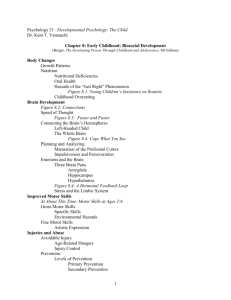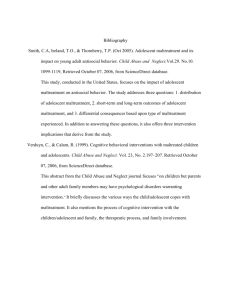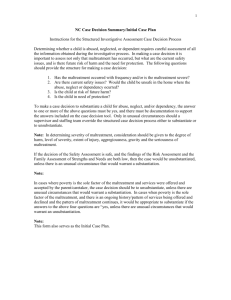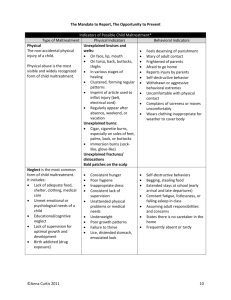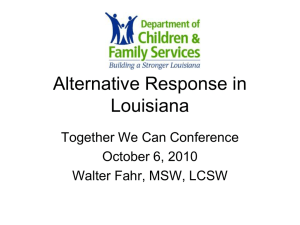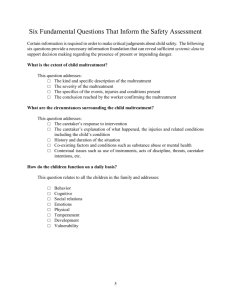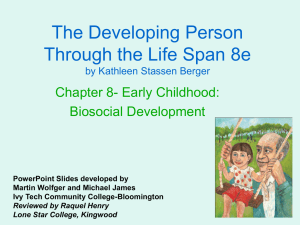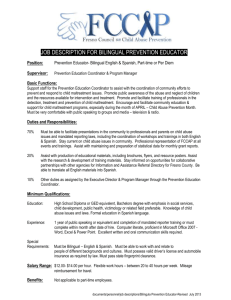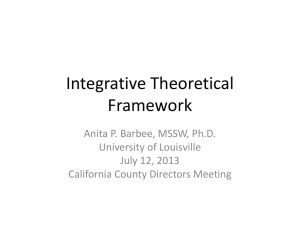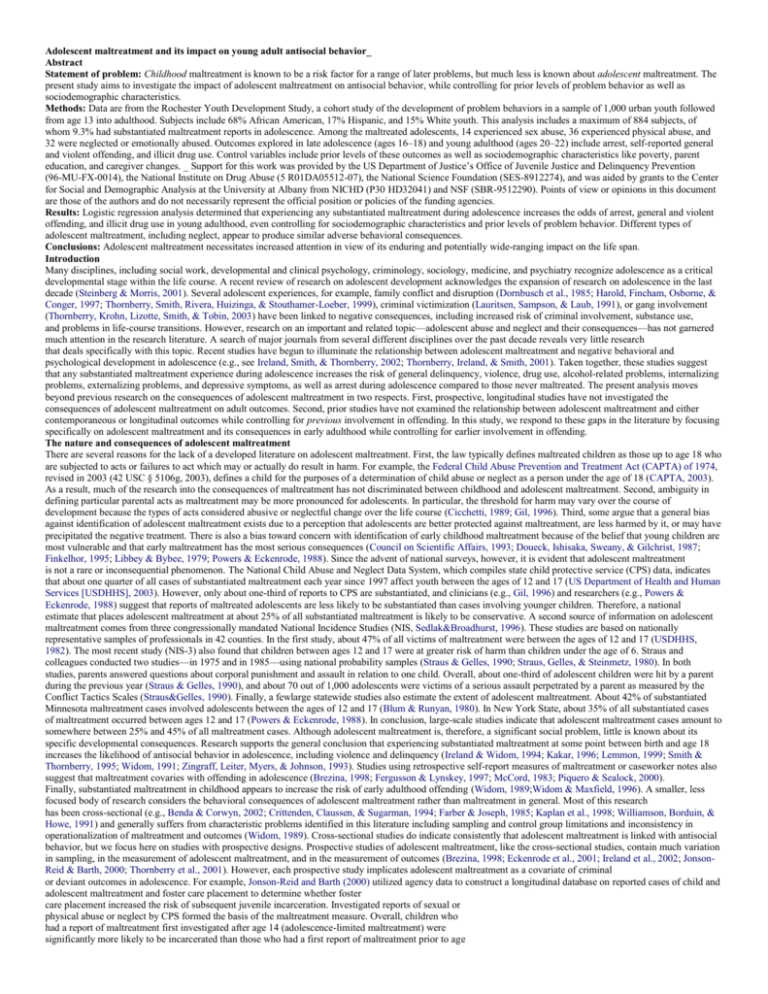
Adolescent maltreatment and its impact on young adult antisocial behavior_
Abstract
Statement of problem: Childhood maltreatment is known to be a risk factor for a range of later problems, but much less is known about adolescent maltreatment. The
present study aims to investigate the impact of adolescent maltreatment on antisocial behavior, while controlling for prior levels of problem behavior as well as
sociodemographic characteristics.
Methods: Data are from the Rochester Youth Development Study, a cohort study of the development of problem behaviors in a sample of 1,000 urban youth followed
from age 13 into adulthood. Subjects include 68% African American, 17% Hispanic, and 15% White youth. This analysis includes a maximum of 884 subjects, of
whom 9.3% had substantiated maltreatment reports in adolescence. Among the maltreated adolescents, 14 experienced sex abuse, 36 experienced physical abuse, and
32 were neglected or emotionally abused. Outcomes explored in late adolescence (ages 16–18) and young adulthood (ages 20–22) include arrest, self-reported general
and violent offending, and illicit drug use. Control variables include prior levels of these outcomes as well as sociodemographic characteristics like poverty, parent
education, and caregiver changes. _ Support for this work was provided by the US Department of Justice’s Office of Juvenile Justice and Delinquency Prevention
(96-MU-FX-0014), the National Institute on Drug Abuse (5 R01DA05512-07), the National Science Foundation (SES-8912274), and was aided by grants to the Center
for Social and Demographic Analysis at the University at Albany from NICHD (P30 HD32041) and NSF (SBR-9512290). Points of view or opinions in this document
are those of the authors and do not necessarily represent the official position or policies of the funding agencies.
Results: Logistic regression analysis determined that experiencing any substantiated maltreatment during adolescence increases the odds of arrest, general and violent
offending, and illicit drug use in young adulthood, even controlling for sociodemographic characteristics and prior levels of problem behavior. Different types of
adolescent maltreatment, including neglect, appear to produce similar adverse behavioral consequences.
Conclusions: Adolescent maltreatment necessitates increased attention in view of its enduring and potentially wide-ranging impact on the life span.
Introduction
Many disciplines, including social work, developmental and clinical psychology, criminology, sociology, medicine, and psychiatry recognize adolescence as a critical
developmental stage within the life course. A recent review of research on adolescent development acknowledges the expansion of research on adolescence in the last
decade (Steinberg & Morris, 2001). Several adolescent experiences, for example, family conflict and disruption (Dornbusch et al., 1985; Harold, Fincham, Osborne, &
Conger, 1997; Thornberry, Smith, Rivera, Huizinga, & Stouthamer-Loeber, 1999), criminal victimization (Lauritsen, Sampson, & Laub, 1991), or gang involvement
(Thornberry, Krohn, Lizotte, Smith, & Tobin, 2003) have been linked to negative consequences, including increased risk of criminal involvement, substance use,
and problems in life-course transitions. However, research on an important and related topic—adolescent abuse and neglect and their consequences—has not garnered
much attention in the research literature. A search of major journals from several different disciplines over the past decade reveals very little research
that deals specifically with this topic. Recent studies have begun to illuminate the relationship between adolescent maltreatment and negative behavioral and
psychological development in adolescence (e.g., see Ireland, Smith, & Thornberry, 2002; Thornberry, Ireland, & Smith, 2001). Taken together, these studies suggest
that any substantiated maltreatment experience during adolescence increases the risk of general delinquency, violence, drug use, alcohol-related problems, internalizing
problems, externalizing problems, and depressive symptoms, as well as arrest during adolescence compared to those never maltreated. The present analysis moves
beyond previous research on the consequences of adolescent maltreatment in two respects. First, prospective, longitudinal studies have not investigated the
consequences of adolescent maltreatment on adult outcomes. Second, prior studies have not examined the relationship between adolescent maltreatment and either
contemporaneous or longitudinal outcomes while controlling for previous involvement in offending. In this study, we respond to these gaps in the literature by focusing
specifically on adolescent maltreatment and its consequences in early adulthood while controlling for earlier involvement in offending.
The nature and consequences of adolescent maltreatment
There are several reasons for the lack of a developed literature on adolescent maltreatment. First, the law typically defines maltreated children as those up to age 18 who
are subjected to acts or failures to act which may or actually do result in harm. For example, the Federal Child Abuse Prevention and Treatment Act (CAPTA) of 1974,
revised in 2003 (42 USC § 5106g, 2003), defines a child for the purposes of a determination of child abuse or neglect as a person under the age of 18 (CAPTA, 2003).
As a result, much of the research into the consequences of maltreatment has not discriminated between childhood and adolescent maltreatment. Second, ambiguity in
defining particular parental acts as maltreatment may be more pronounced for adolescents. In particular, the threshold for harm may vary over the course of
development because the types of acts considered abusive or neglectful change over the life course (Cicchetti, 1989; Gil, 1996). Third, some argue that a general bias
against identification of adolescent maltreatment exists due to a perception that adolescents are better protected against maltreatment, are less harmed by it, or may have
precipitated the negative treatment. There is also a bias toward concern with identification of early childhood maltreatment because of the belief that young children are
most vulnerable and that early maltreatment has the most serious consequences (Council on Scientific Affairs, 1993; Doueck, Ishisaka, Sweany, & Gilchrist, 1987;
Finkelhor, 1995; Libbey & Bybee, 1979; Powers & Eckenrode, 1988). Since the advent of national surveys, however, it is evident that adolescent maltreatment
is not a rare or inconsequential phenomenon. The National Child Abuse and Neglect Data System, which compiles state child protective service (CPS) data, indicates
that about one quarter of all cases of substantiated maltreatment each year since 1997 affect youth between the ages of 12 and 17 (US Department of Health and Human
Services [USDHHS], 2003). However, only about one-third of reports to CPS are substantiated, and clinicians (e.g., Gil, 1996) and researchers (e.g., Powers &
Eckenrode, 1988) suggest that reports of maltreated adolescents are less likely to be substantiated than cases involving younger children. Therefore, a national
estimate that places adolescent maltreatment at about 25% of all substantiated maltreatment is likely to be conservative. A second source of information on adolescent
maltreatment comes from three congressionally mandated National Incidence Studies (NIS, Sedlak&Broadhurst, 1996). These studies are based on nationally
representative samples of professionals in 42 counties. In the first study, about 47% of all victims of maltreatment were between the ages of 12 and 17 (USDHHS,
1982). The most recent study (NIS-3) also found that children between ages 12 and 17 were at greater risk of harm than children under the age of 6. Straus and
colleagues conducted two studies—in 1975 and in 1985—using national probability samples (Straus & Gelles, 1990; Straus, Gelles, & Steinmetz, 1980). In both
studies, parents answered questions about corporal punishment and assault in relation to one child. Overall, about one-third of adolescent children were hit by a parent
during the previous year (Straus & Gelles, 1990), and about 70 out of 1,000 adolescents were victims of a serious assault perpetrated by a parent as measured by the
Conflict Tactics Scales (Straus&Gelles, 1990). Finally, a fewlarge statewide studies also estimate the extent of adolescent maltreatment. About 42% of substantiated
Minnesota maltreatment cases involved adolescents between the ages of 12 and 17 (Blum & Runyan, 1980). In New York State, about 35% of all substantiated cases
of maltreatment occurred between ages 12 and 17 (Powers & Eckenrode, 1988). In conclusion, large-scale studies indicate that adolescent maltreatment cases amount to
somewhere between 25% and 45% of all maltreatment cases. Although adolescent maltreatment is, therefore, a significant social problem, little is known about its
specific developmental consequences. Research supports the general conclusion that experiencing substantiated maltreatment at some point between birth and age 18
increases the likelihood of antisocial behavior in adolescence, including violence and delinquency (Ireland & Widom, 1994; Kakar, 1996; Lemmon, 1999; Smith &
Thornberry, 1995; Widom, 1991; Zingraff, Leiter, Myers, & Johnson, 1993). Studies using retrospective self-report measures of maltreatment or caseworker notes also
suggest that maltreatment covaries with offending in adolescence (Brezina, 1998; Fergusson & Lynskey, 1997; McCord, 1983; Piquero & Sealock, 2000).
Finally, substantiated maltreatment in childhood appears to increase the risk of early adulthood offending (Widom, 1989;Widom & Maxfield, 1996). A smaller, less
focused body of research considers the behavioral consequences of adolescent maltreatment rather than maltreatment in general. Most of this research
has been cross-sectional (e.g., Benda & Corwyn, 2002; Crittenden, Claussen, & Sugarman, 1994; Farber & Joseph, 1985; Kaplan et al., 1998; Williamson, Borduin, &
Howe, 1991) and generally suffers from characteristic problems identified in this literature including sampling and control group limitations and inconsistency in
operationalization of maltreatment and outcomes (Widom, 1989). Cross-sectional studies do indicate consistently that adolescent maltreatment is linked with antisocial
behavior, but we focus here on studies with prospective designs. Prospective studies of adolescent maltreatment, like the cross-sectional studies, contain much variation
in sampling, in the measurement of adolescent maltreatment, and in the measurement of outcomes (Brezina, 1998; Eckenrode et al., 2001; Ireland et al., 2002; JonsonReid & Barth, 2000; Thornberry et al., 2001). However, each prospective study implicates adolescent maltreatment as a covariate of criminal
or deviant outcomes in adolescence. For example, Jonson-Reid and Barth (2000) utilized agency data to construct a longitudinal database on reported cases of child and
adolescent maltreatment and foster care placement to determine whether foster
care placement increased the risk of subsequent juvenile incarceration. Investigated reports of sexual or
physical abuse or neglect by CPS formed the basis of the maltreatment measure. Overall, children who
had a report of maltreatment first investigated after age 14 (adolescence-limited maltreatment) were
significantly more likely to be incarcerated than those who had a first report of maltreatment prior to age
14 (childhood maltreatment).
Eckenrode et al. (2001) followed a sample of mothers and children 15 years after the birth of the child to
see whether the timing of substantiated maltreatment (no maltreatment, childhood-limited, adolescencelimited,
persistent maltreatment) affected the early onset of negative behaviors. They found that those with
no substantiated maltreatment and those with childhood-limited maltreatment were statistically identical
when looking at the early onset of problem behaviors. However, those with adolescence-limited and
persistent maltreatment had significantly earlier onset of negative behaviors compared to those never
maltreated.
Finally, two studies using data from the Rochester study focused on the adolescent consequences of
experiencing substantiated maltreatment. Ireland et al. (2002) tested the impact of maltreatment that
occurred during different developmental stages on delinquency and drug use. They found that both
adolescence-limited and persistent maltreatment increased the risk of a variety of delinquent outcomes
(official and self-reported) in early and late adolescence compared to those never maltreated. In contrast,
experiencing childhood-only maltreatment did not significantly increase the risk of delinquency during
adolescence. Thornberry et al. (2001) extended this analysis to examine several additional behavioral
and psychological outcomes in adolescence. In general, adolescent maltreatment (adolescent-limited
or persistent maltreatment) led to a variety of negative consequences in early and late adolescence
such as delinquency, drug use, teen pregnancy, internalizing problems, and multiple problem outcomes.
Experiencing childhood-limited maltreatment, though, did not significantly increase the risk of negative
outcomes in late adolescence when compared to those never maltreated. Finally, analysis of maltreatment
subtypes indicated that those who experienced adolescent physical abuse and neglect (but not sexual
C.A. Smith et al. / Child Abuse & Neglect 29 (2005) 1099–1119 1103
abuse) were likely to display more generalized and serious consequences in late adolescence when compared
to those never maltreated.
Summary and research questions
Overall, in the published research there is great variation in the measurement of adolescent maltreatment,
sampling strategies, use of controls, statistical methodology, and operationalization of outcomes.
Maltreatment measures range from self-reports of some subtypes of abuse (e.g., Benda & Corwyn, 2002;
Brezina, 1998) to CPS substantiation of any maltreatment incident (e.g., Eckenrode et al., 2001; Ireland et
al., 2002). Few studies examined neglect and emotional maltreatment. There is also broad diversity in the
negative outcomes considered. Outcomes include self-reported measures of delinquency and incarceration,
DSM-III-R diagnosis of conduct disorder, early onset of diverse problem behaviors, and multiple
problem behaviors.
Such variation in the research makes it difficult to draw firm conclusions about the negative consequences
of adolescent maltreatment. Nevertheless, these studies consistently indicate that experiencing
adolescent maltreatment is developmentally disruptive in the short term. However, at least three unexplored
questions remain.
First, which came first, the maltreatment or the disruptive behavior? Cross-sectional studies cannot
answer this question. Longitudinal studies potentially establish temporal order between adolescent
maltreatment and subsequent behavior, but the maltreatment may be the culmination of ongoing problematic
behavior on the part of the adolescent. One way to begin to address this complex issue is to
control statistically for earlier involvement in delinquency. Results from such a strategy would indicate
whether experiences of adolescent maltreatment affect delinquent behavior. In other words, irrespective
of previous involvement in delinquency, does experiencing adolescent maltreatment result in subsequent
increases in offending? Second, the current research on the consequences of adolescent maltreatment
estimates either contemporaneous or short-term effects. What remains unknown is whether the negative
behavioral consequences of such experiences persist into early adulthood. Does involvement in offending
among those who experience adolescent maltreatment dissipate over time? Third, does the type of
maltreatment experience matter, or are the consequences similar regardless of the type of adolescent
maltreatment? Furthermore, are the negative behavioral consequences of one type of adolescent maltreatment
short-term, while another type of adolescent maltreatment might have relatively long-term
effects?
In this study, we begin the process of addressing these three issues using prospective data from the
Rochester Youth Development Study (RYDS), a longitudinal study with high retention that has followed
a representative panel of 1,000 urban youth since age 13. The longitudinal design of the Rochester study
enables the ordering of adolescent maltreatment and of later outcomes. Specifically, we address the
following research questions:
1. What is the distribution of adolescent maltreatment in an urban community sample?
2. After taking into account previous delinquent behavior and sociodemographic characteristics, what is
the short-term impact of adolescent maltreatment on offending, violence, drug use, and arrest? Does
this impact extend into early adulthood?
3. Do the short-term effects and the long-term effects of adolescent maltreatment vary by the type of
maltreatment experienced?
1104 C.A. Smith et al. / Child Abuse & Neglect 29 (2005) 1099–1119
Methods
The RYDS is designed to examine the causes and consequences of drug use and delinquent behavior
in a high-risk urban sample. Selection of participants and measurement of key constructs have been
described in detail by Smith and Thornberry (1995), Thornberry et al. (2001), and Ireland et al. (2002)
and are only briefly summarized here. The RYDS is a multiwave panel study in which youths and their
primary caretakers (in 95% of the cases, the mother or stepmother) were initially interviewed every 6
months and then at three annual interviews. At the first interview, subjects were on average about 13.5
years old; at the 12th interview, their average age was 22. Data were collected in two phases: during the
first phase subjects were, on average, aged 13.5–17.5 years old. During the second phase, subjects were,
on average, 20–22 years old. Procedures to protect human subjects were approved by the University at
Albany’s IRB, and included written informed parental consent for parents and students, as well as student
assent, which was read to participants. As students turned age 18, their written informed consent was
obtained directly. Data were also collected from the schools, police, and social services. This analysis
makes use of interview data from parents and children, arrest data from police records, and data on
maltreatment from Child Protective Services records.
Sample
In order to obtain a sufficient number of youth at high risk for serious delinquency and drug use,
the overall sample was stratified, with males being overrepresented because they are more likely than
females to engage in serious delinquency. Also, students were selected in proportion to the resident arrest
rate of the census tract in which they lived at the time the study began. A final panel of 1,000 students
and their families was selected for the study. Although the sample overrepresents at-risk youth, the full
continuum of urban adolescents is included (Farnworth, Thornberry, Krohn,&Lizotte, 1994). Because the
probability of selection of each subject is known, this sampling strategy provides a means for weighting
the sample to represent the initial population of 7th and 8th graders in the Rochester Public Schools and
all nondescriptive findings are weighted here. Overall, 85% of the original sample was interviewed at the
12th interview, and there is no evidence of differential attrition (Krohn & Thornberry, 1999; Thornberry
et al., 2003).
Measurement
Maltreatment. The measure of maltreatment is based on data obtained from the Child Protective Services
(CPS) records of the Monroe County Department of Social Services, the county of residence for all
subjects at the start of the RYDS project. Maltreatment, by definition, involves harm or risk of harm
to children occurring within the context of the family, that is, “by a person responsible for the child’s
welfare” (Public Law 93-237, section 2). For all 1,000 subjects in the Rochester study, any incident
of substantiated maltreatment was recorded and coded from birth through 1992, when subjects were
completing high school.
Details on each maltreatment incident were coded from CPS case records according to the classification
system developed by Cicchetti (Cicchetti&Barnett, 1991) for which there is ample evidence of reliability
and validity (Bolger, Patterson, & Kupersmidt, 1998; Cicchetti & Barnett, 1991; Manly, Cicchetti, &
Barnett, 1994). For this analysis, two maltreatment measures are utilized: age at maltreatment and type
C.A. Smith et al. / Child Abuse & Neglect 29 (2005) 1099–1119 1105
of maltreatment. Age at time of maltreatment comes from the incident date in the case record. Coders
define descriptions of incidents as including one or more of five types of maltreatment, including physical
and sexual abuse, emotional maltreatment, physical neglect and moral/legal/educational maltreatment;
exemplars are used to describe these categories. A more detailed description of the coding procedures can
be found in Barnett, Manly, and Cicchetti (1993) and, as applied to these data, in Smith and Thornberry
(1995). Inter-rater reliability among coders was estimated at about .8.
To be considered maltreated during adolescence, the subject had to have one or more substantiated
cases of maltreatment in the CPS files after his or her 12th birthday. A total of 82 adolescents had a
substantiated case of maltreatment between the ages of 12 and 17, representing 9.3% of the total sample
(10% of the weighted sample).
Subjects with childhood-limited maltreatment (116 unweighted, 107 weighted cases) are excluded
from the analysis in view of our previous analyses demonstrating that by late adolescence the problem
behavior of those maltreated only in childhood was statistically identical to the behavior of those never
maltreated (Ireland et al., 2002; Thornberry et al., 2001). The maximum sample available for analysis is,
therefore, 884.
Amajority of the adolescent maltreated subjects in the Rochester sample experienced at least two different
types of substantiated maltreatment, which is consistent with other maltreatment research (Crittenden
et al., 1994; McGee,Wolfe,&Wilson, 1997). Because of the overlap of types of maltreatment, we created
subtypes of maltreatment by following the classification scheme developed by Cicchetti and Rogosch
(1997). If subjects experienced any adolescent sexual abuse, they are placed into the sexual abuse category.
If they experienced any adolescent physical abuse but no sexual abuse, they are categorized as physically
abused. Experiences of physical neglect and moral/legal/educational maltreatment were categorized as
neglect. Neglect and emotional maltreatment showed substantial overlap in occurrence, as well as in precursors
and consequences, and were classified together (McGee & Wolfe, 1991; Rosenzweig & Kaplan,
1996). Only 8% of subjects experienced just emotional maltreatment. The distribution of maltreatment
variables, as well as other variables in the analysis, is shown in Table 1, and discussed below. Table 1
presents unweighted data only.
Antisocial behavior. Because the focus here is on antisocial behavior, which covers a range of behaviors,
four measures are used. Three self-report measures are employed: general offending, violent offending,
and drug use. Arrest—an official measure—is also used as an indicator of adolescent antisocial behavior,
although it also reflects criminal justice activities. Two time frames are considered: late adolescence
and early adulthood. The strength of using multiple measures of antisocial outcomes across time is
that one is able to look for consistent patterns that suggest a higher level of confidence in the overall
findings.
At each interview, a set of self-reported offending and drug use questions asked whether or not the
respondent committed a particular offense in the interval between the previous and current interviews and,
if so, the frequency of those behaviors. Prevalence measures for these three outcomes—general offending,
violent offending, and drug use—were constructed for two different intervals: late adolescence and early
adulthood. Late adolescence measures cover a 2-year time frame from approximately ages 16–18 and
are based on data from four interviews conducted at 6-month intervals. If the subject reports the behavior
falling into the category of interest at any or all points during this time period, they are treated as engaging
in the behavior. Early adulthood outcome measures are derived from three annual interviews and cover
approximately ages 20–22.

